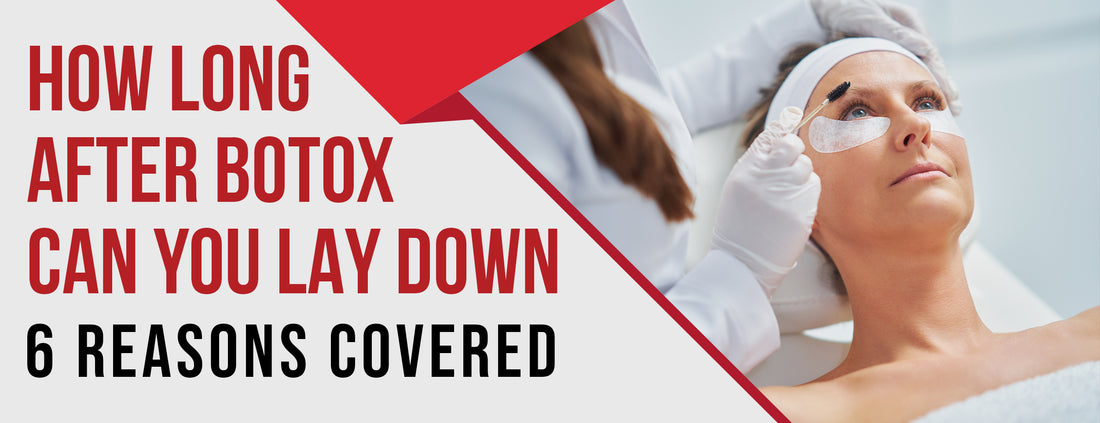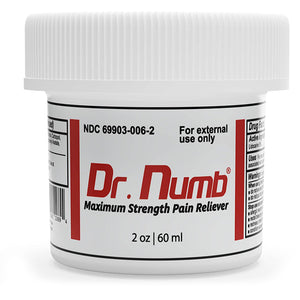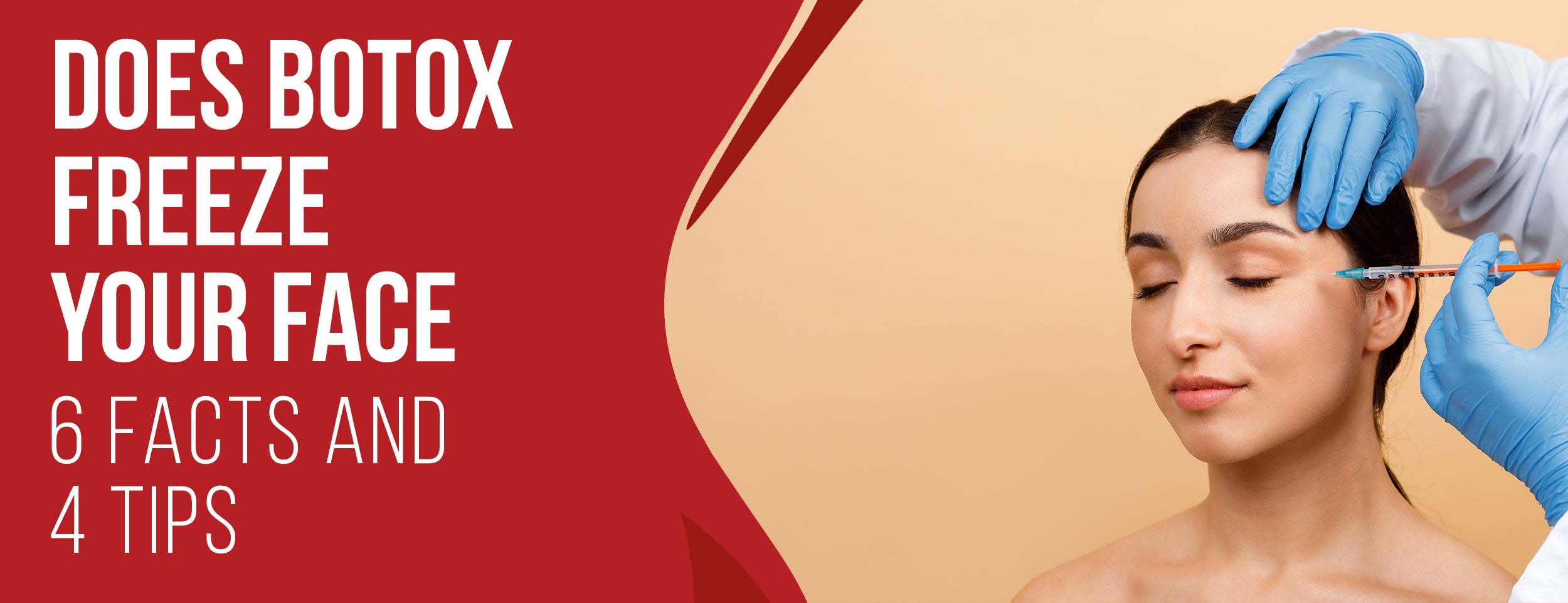Have you recently received Botox injections and are wondering how long you should wait before lying down? It's a common question that many patients have after their Botox treatment. You must wait at least four hours after Botox injections before lying down.
Lying down too soon after the injection can increase the risk of spreading the toxin and bruising the injection site. But that's not all. Waiting for at least four hours can also help to prevent migrating and excessive swelling.
In this blog post, we'll dive into more details and facts about how long after Botox you can lay down and why sleeping on your back is essential if you have Botox in the face.
How Long After Botox Can You Lay Down: 6 Reasons

Botox injections have become popular for people looking to smoothen out facial and neck wrinkles. Lie down, sit, or exercise safely after Botox injections. Before performing any of these activities, knowing the appropriate waiting time is crucial.
Recommended Waiting Time
After receiving Botox injections, waiting for a specific period before lying down is generally advisable. The typical recommended waiting time is:
- 4 Hours: Most healthcare providers suggest waiting at least four hours before lying down horizontally, allowing the Botox to settle and minimizing migration risk to unintended areas.
Factors That May Impact Waiting Time
You should wait four hours before lying down after Botox injections. Botox injection sites and amounts may influence the waiting time. Following post-treatment instructions is essential to ensure the procedure's effectiveness and safety. Here are some tips and factors to consider:
- Injection Site: The location of the injections matters; some areas may require longer waiting times due to muscle sensitivity and the risk of spreading the Botox to adjacent muscles.
- Dosage: Larger doses might necessitate a slightly longer waiting period to ensure the toxin remains localized.
- People's Response: People's reactions to Botox can vary, so some people might need more time than others before resuming normal activities.
Importance of Following Post-Treatment Instructions

For safety and effectiveness, follow post-treatment instructions strictly:
- Enhanced Results: Following recommended guidelines helps ensure that Botox remains in the intended areas, optimizing its cosmetic effects.
- Minimized Risks: Waiting a few minutes before lying down or engaging in strenuous activity decreases the chances of complications.
- Consultation: Talk to your healthcare provider about post-Botox care; their recommendations may differ based on your treatment plan.
How Laying Down After Botox Injections Can Affect Results?
After Botox injections, lying down can affect the outcome and safety of the procedure. Here are three key aspects to understand these effects:
Increased Risk of Migration
Injecting Botox too soon after receiving it can cause it to migrate unintentionally. As Botox temporarily blocks nerve signals, immediate horizontal positioning may encourage the substance to spread.
To mitigate this risk, experts typically recommend waiting at least 4 hours post-injection before lying down. Botox patients can maximize their recovery with this precaution and understand the dynamic of the treatment to avoid unintended side effects.

Pressure on Injection Sites
Laying down with your head or face on a surface may exert pressure on the injection sites. Pressure may alter the distribution of Botox within muscles, potentially affecting its effectiveness.
- Injection Site Pressure: Lying down places pressure on the injection sites, potentially causing the Botox solution to spread beyond the intended areas. This can lead to uneven results and undesirable side effects.
- Optimal Results: You should maintain an upright position for at least 4 hours after your Botox treatment to get the best results. This allows the injected Botox to settle in the targeted muscles without any unwanted migration.
- Preventing Complications: Avoiding lying down minimizes the risk of complications such as eyelid drooping or uneven muscle relaxation, which can occur if the Botox spreads to unintended regions.
- Aftercare Importance: Following aftercare guidelines, including refraining from lying down, contributes to a successful and satisfactory Botox experience. By Taking precautions to these precautions, you support the precision of the injections and enhance the longevity of your results.
Impact On Blood Flow

The position of the body when lying down can impact blood circulation. Reduced blood flow in the treated areas might slow the absorption and diffusion of Botox, potentially delaying the onset of desired effects.
Follow your healthcare provider's post-injection instructions carefully, which may include specific guidelines about positioning and activity immediately after your Botox treatment.
Recommended Sleeping Position After Botox Injections
While sleeping, it is important to take extra care to avoid moving the Botox from its intended target area, resulting in unfavorable results. After the procedure, patients should avoid sleeping on their stomachs or sides.
Ideal Sleeping Positions
- Back Sleeping: Sleeping on your back is highly recommended after Botox injections. This position enhances your treatment's effectiveness and utilizes gravity to your advantage.
- Optimizing Botox Results: Sleeping on your back helps ensure that the injected Botox settles evenly in the treated areas, allowing for the best possible results from your treatment.
- Wrinkle Reduction: This position also aids in reducing the appearance of wrinkles and fine lines over time. By avoiding facial contact with pillows and sheets, you minimize the risk of Botox shifting and can enjoy longer-lasting youthful effects.
- Promoting Skin Health: Back sleeping maintains your Botox investment and promotes overall skin health, making it a valuable habit to support your beauty and skincare goals.
How To Protect Injection Sites While Sleeping?

For proper healing and even Botox distribution, injecting the injection sites during sleep is essential:
- Use a Soft Pillow: Opt for a soft pillow that provides gentle support to the head without causing excessive pressure on the face.
- Pillow Placement: Position the pillow strategically to avoid contact with the injection areas, ensuring a comfortable and safe sleep.
Importance of Avoiding Pressure on Injection Sites
Your Botox treatment will be more successful if you prevent pressure at injection sites:
- Preserve Results: Minimizing pressure helps prevent the displacement of the Botox within the tissues, preserving the intended results.
- Reduce Bruising: Avoiding pressure can also minimize the risk of post-injection bruising and swelling, allowing for a smoother recovery process.
Following these recommended sleeping positions and protecting the injection sites can maximize the effectiveness of your Botox treatment and ensure a comfortable recovery.

What Can Happen If A Patient Lies Down Too Soon After the Treatment?
Certain medical treatments can make patients feel disposed to lying down and resting immediately afterward. Treatment received too soon can often lead to negative consequences.
Complications Such As Bruising or Swelling
Laying down prematurely after a Botox treatment can potentially lead to complications, including:
- Spread of Toxin Risk: Lying down shortly after Botox injections can increase the risk of the toxin spreading beyond the intended injection site. This spread may lead to complications like bruising or swelling due to the migration of the injected substance within the treated area.
- Bruising Potential: Bending or lying down within the first four hours after Botox injections can disrupt the initial healing process. This disruption might make blood vessels more prone to damage, leading to potential bruising at the injection sites.
Migration of Botox Toxin

Immediate post-treatment positioning is important to prevent:
- Brow Heaviness or Ptosis: Injecting Botox toxin too high or too laterally can lead to its migration to the frontalis muscle. This can result in the unintended side effects of brow heaviness or ptosis, where the eyebrows appear lowered or droopy. Patients may experience a loss of their natural brow arch and an overall tired or aged appearance.
- Migration to Levator Palpebrae Superioris Muscle: When Botox is injected too deeply into the lateral corrugators, there's a risk of toxin migration downwards. This migration can affect the levator palpebrae superioris muscle that raises the upper eyelid. Consequently, patients may encounter issues with eyelid movement and experience drooping or ptosis of the upper eyelid.
The Importance of Following These Recommendations
For optimal outcomes, follow the post-treatment guidelines:
- Botox injections are a minimally invasive cosmetic procedure involving injecting the botulinum toxin into muscles to paralyze them and temporarily reduce wrinkles' appearance.
- After Botox treatment, patients should avoid lying flat on their backs or having their head below their heart for at least four hours post-treatment.
- Toxins can spread to unintended areas if you lay down right after treatment, resulting in droopy eyelids, asymmetrical facial features, or difficulty swallowing.
- Avoiding strenuous exercise after treatment or massaging the affected areas can ensure a safe and effective outcome.
- A follow-up appointment with your healthcare provider is also recommended to assess the treatment results and make any necessary adjustments.
Conclusion:
Receiving Botox injections is a life-changing decision that helps thousands of people regain their confidence in their appearance. Following pre and post-procedure instructions is crucial to get the best results possible. Laying flat or sleeping immediately after Botox can hinder its effectiveness as it may spread away from the target site.
Therefore, it is recommended that you wait for at least 4 hours before lying down or sleeping. While the 4-hour recommendation is generic, we recommend you follow your medical professional’s specific advice to ensure you get optimal results. So, go ahead and get your Botox done, and remember to follow the post-procedure instructions for a smooth healing process.















1 comment
Thanks for the nice article!